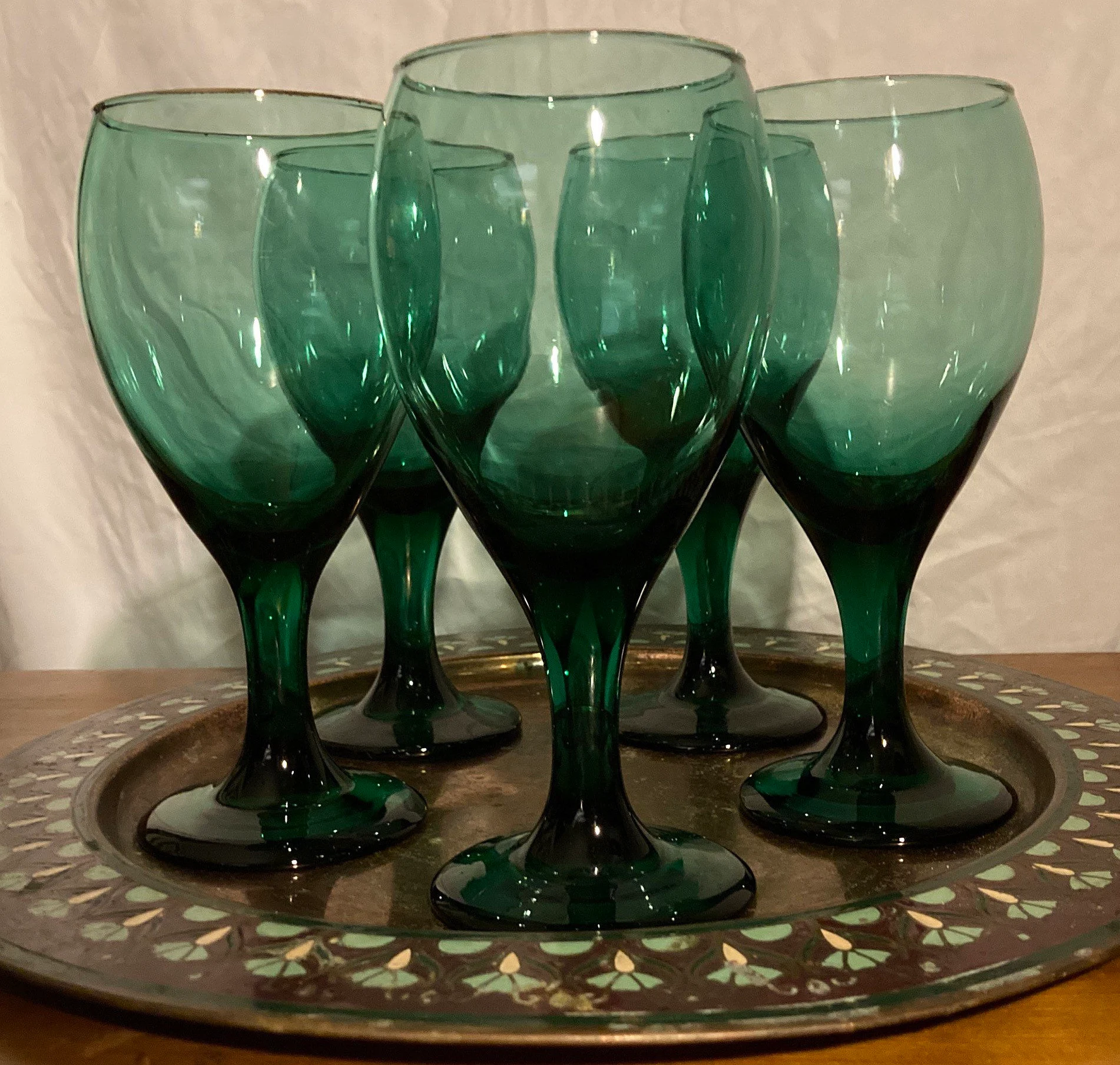Do you want to become a glassware collector? Libbey Glassware is probably one of the oldest and most valuable brands in the glassware market. This article will tell you how this company became the largest. Likewise, we will show you how to get started in the world of glassware collection.
With us, you will learn how to know when you are in front of a good collection piece and how to value each glassware. Stay with us to find out more!
Table of Contents
The History of Vintage Libbey Glassware
To recognize why Libbey is a vintage brand, it’s necessary to repair its history. In 1818 the New England Glass Company (Libbey Glass) was founded, specifically in East Cambridge, Massachusetts. They were known for their quality pieces and for using the pressed glass process.
In 1870, the company became operationally involved with the Libbey family. William L. Libbey leased the New England Glass Company and changed its name to W.L Libbey and Son. Although the company was doing well in MA, it was not growing as expected, so the board of directors decided to move it to Ohio.
The first pieces were goblets, glasses, and the famous cut-glass-covered butter dish, which caused a stir, thanks to their standard strawberry, gem pattern, hobstar, and fan motif designs.
In 1892 the company changed its name again, making it more straightforward; Libbey Glass Company. The excellence of Libbey’s glass cutting was so perfect that the company was awarded many times with gold medals.
By 1920, the increase in labor and fuel caused orders for glassware to decline, and Libbey had to require mainly pieces for hotels, bars, and restaurants. In 1924, the new series specialized in tableware and produced formal stemware and matching centerpieces of candlesticks, bowls, and vases.
Libbey returned to homes in 1950, a wise economic move as the brand posted solid growth in sales.
Over the past two decades, Libbey’s oldest and best-crafted glassware has been considered vintage antiques and can be worth hundreds of dollars.
Early manufacturers of Libbey Vintage Glassware
In 1818, the New England Glass Company (NEGC), a company with four owners where only a man called Deming Jarvis had business experience, joined the glass industry. This company was Libbey Glass’s predecessor and the first Vintage Libbey glassware manufacturer.
The company had humble beginnings, with just two ovens, twelve pots, and a cutting department. However, good work made the store a complete success. Some five years later, the company already had more than 140 workers, surpassing the mark of 10 tons of glassware produced.
It is said that the success of the NEGC was mainly due to a man who became foreman of the company in 1826, Thomas Leighton Sr.
They were generally known for impeccable glass work and for making the tempered glass technique fashionable, giving each piece a cleaner and more personalized aesthetic.
The New England Glass Company would pass into the hands of the Libbey family, who would change the name and headquarters of the company.
How to identify a Vintage Original Libbey Glassware
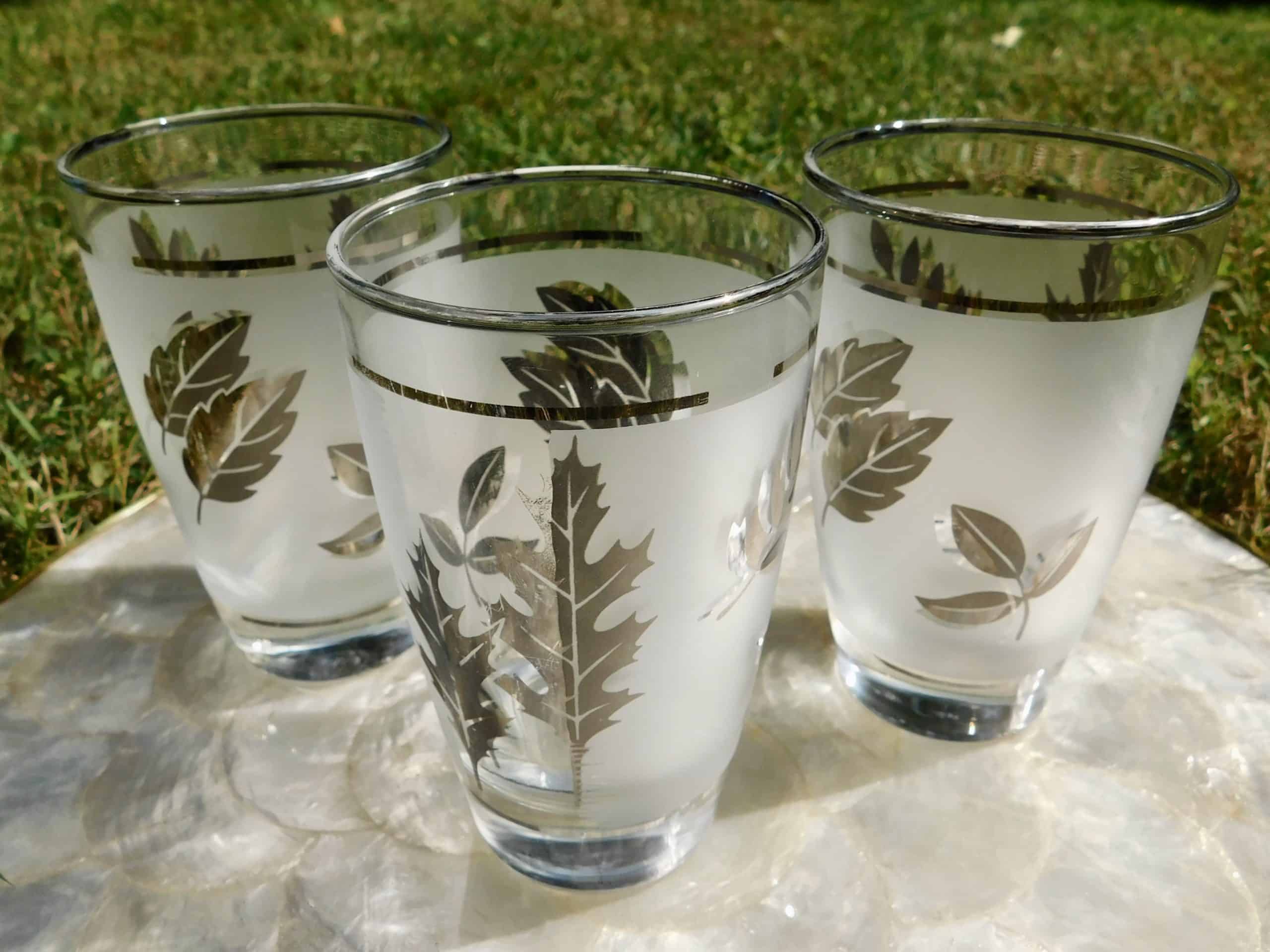
To recognize an authentic Libbey Glass, you must check the piece very well, not only the technique used in the glass but also some distinctive manufacturing marks.
Identifying a Vintage Libbey Glass
Like most manufacturers, the Libbey Glass Company stamped various trademarks on its pieces to indicate to buyers that they were genuine. Several variants of the Libbey glassware signature exist. Each one would tell you about the collection date.
- 1920 to 1936: Libbey used a trademark with his initial “L” cursive and within a double circle. In case you see this mark, the piece was likely created between 1920 and 1936.
- 1937 and 1954: By this time, Libbey changed its company brand, it was no longer a double circle but only a segmented circle, and inside this, the famous cursive and capitalized “L”.
- 1955 – 1980: After a long time, Libbey changed its trademark again; the segmented circle was gone, only leaving a minimalist circle where the famous “L” would be found inside.
- Now: Currently, the company has only kept the stamp of its distinctive letter “L” that everyone recognizes when seeing one of these mythical pieces
In recent decades, Libbey Glass decided to do away with the circle and stick with just the cursive ‘L,’ with even more impeccable delicacy, which also speaks to new techniques for handling glass.
Other features that can help you identify a vintage Libbey is to see if they match the patterns of the era: strawberry and shine diamond pattern, gem pattern, hobstar pattern, and fan motifs. In our “How to date a vintage Libbey Glassware” section, we will tell you more about it.
Types of Vintage Libbey Glass
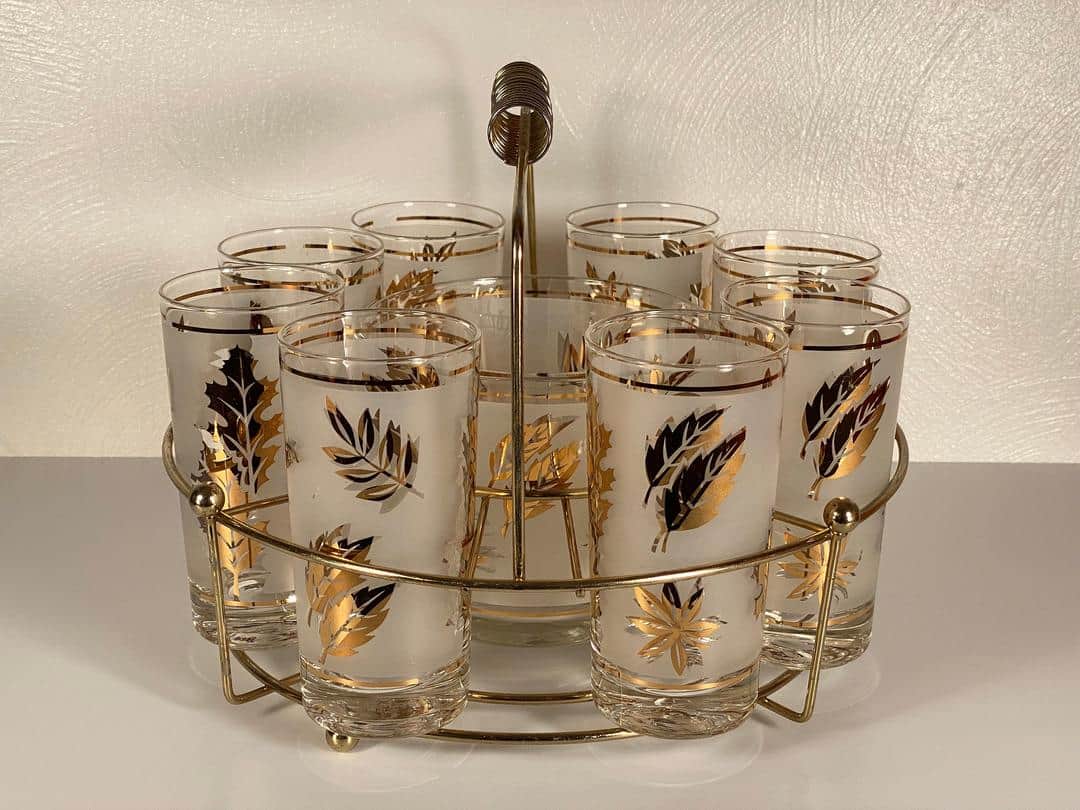
Being a prolific glassware manufacturer, it is only natural that Libbey has a lot of types of pieces. However, in its history, some very peculiar types stand out, these being the most notable when a collection is created.
- Tumblers: This is the standard glass whose straight body is neither too big nor too small, ideal for everyday use. Libbey loved using Ashburton and Huber patterns on tumblers, especially in the 70s.
- Collins glasses: Collins glasses are tall, skinny glasses often used to serve summer cocktails like the namesake cocktail or a mojito. Infallible in any home where parties are held.
- Covered compote: Compotes were everywhere, and in the 1879s, The Libbey company created the most outstanding pieces. They can be recognized by their shiny diamond and Huber patterns.
- Stem: Stem glasses are the perfect type of glassware for a restaurant or a night out at home. Many of Libbey’s standout pieces were stem glasses, characterized by elegantly patterned handles, usually spiral or striped.
- Decanter: One of Libbey’s most fantastic glass works was their decanters. These liquid containers were famous for their diamond point pattern and natural motifs.
- Whiskey glasses: the Whiskey glass or on the rock glass is small, ideal for serving strong drinks or just with ice. Some of Libbey’s most expensive pieces are of this type, especially those made of glass.
Besides these glasses, Libbey created perfume decanters, ewer, seals, oil lamps, and cream pitchers.
Vintage Libbey Glass Decorations
Although Libbey is known for being a company that covers thousands of themes in its decorations to satisfy its customers, some are more popular, and those attract more attention from collectors, so you should be on the lookout if you come across some of these.
- Animal patterns
- Holiday designs
- Frosted glass with spectacular scenes
- Hours and carousel
- Arts
- Natural motifs like leaves
- Abstract patterns like shine diamond, sharp diamond, and blaze.
How to date a vintage Libbey Glassware
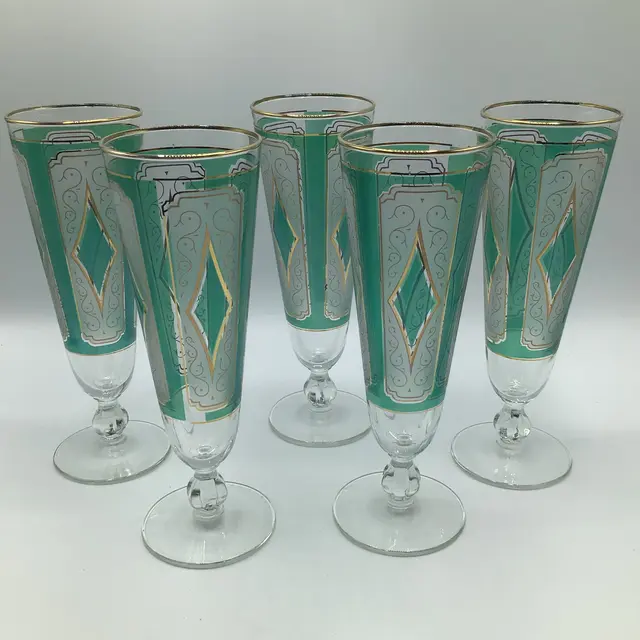
The oldest Libbey pieces date back to the early 1980s when the company was called the New England Glass Company. The older a collection is, the more valuable it will be. To identify a Libbey Vintage Glassware, it is necessary that you observe each part of the piece to define what period it is from.
- Stems: The glassware steams can tell us what’s the date they were made. A Palette twist is an opaque or colored type of stem manufactured in the early 80s. Facet cut stems were common between 1880 and 1920. From the 1920s through the 1980s, Libbey Stems were more understated, colorful, and sophisticated.
- Engraving: Early Libbey Vintage Glassware engravings had shine diamond, sharp diamond, and blaze patterns. When the 1900s arrived, the company kept the diamond patterns but gradually moved on to more floral, natural, or elegant patterns. By the 1960s, 70s, and 80s, the use of gold, precious stones, colors, and figures became more common.
- Foot: Glassware feet are another feature to look for when dating a piece. Take into account what type of foot the product has. Is it separated from the stem? Is flat? Curved? Short or elongated? Every detail counts. The first Libbey glasses (1820 – 1850) were slightly curved feet.
- Weight: The heavier the glass in a product, the older it is. In fact, it is after the 1850s that Libbey begins to reduce the weight of his glassware. The last pieces are much lighter, almost imperceptible.
- Glass color: The color of the glass or crystal can tell you what era a collection is from. Vintage collections tend to have gray or even olive-colored glass. The glass will look blueish on newer pieces, while it will have fairly deep transparency on recent products.
To date a Libbey Vintage Glassware, you must see if all its parts are related to the same year. If not, it is probably not a vintage piece but a recently created product using old manufacturing techniques.
4 Notables Libbey Vintage Glasses
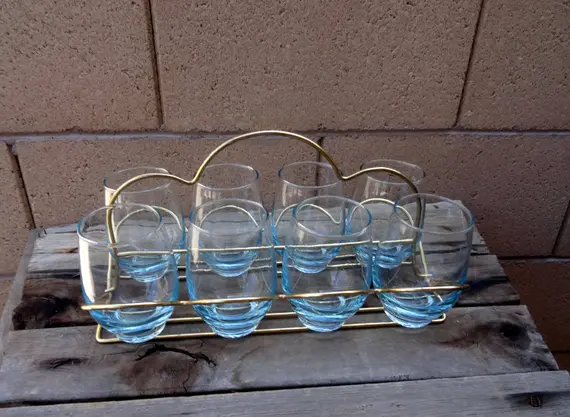
Apart from Libbey’s first decade, these incredible vintage collections of the ’60s are worth your attention.
1. Vintage Libbey glasses and caddies (1962)
Libbey Glass promote in 2962 a series of collections of glasses and caddies with outstanding design. The most popular Crystal HobNob glasses were probably made of blown crystal with a hobnail bottom. Actually, it was the bottom of the glass the superstar, because it was made of a lot of crystal bubbles that looked just fantastic.
Another incredible set was the Golden Ice with 8 pieces, including a Snack Rack and Collins glasses.
2. Aqua HobNob, Colors, and Roses (1963)
In 1963, Libbey wanted to spark new fashion on the table. That’s why they created collections with squares, Nordic radiant colors, 22k gold bands, and roses bouquet patterns. In the 60s, color was becoming a trend, and the glassware company knew it.
3. Dimensional designs from Libbey (1960)
In 1960, glassware changed tremendously. Libbey introduced into the market dimensional designs with textures and high contrast colors, like bronze, gold, and pink. The century-modern collection offered tumblers and shot glasses with nature motifs like flowers and leaves.
Each glass was an inspiration from a flower, you could tumblers named Danube and roses.
4. Emeralds Libbey Glassware (1961)
An Unbelievable attractive set, the “Emeralds” by Libbey was glassware inspired in the oriental culture with real emeralds encrusted and protected by a chip-defiant gold rim. But wait, there’s more; the glasses have the glitter of scrolls traced in 22k gold that really exalt the green of the emeralds.
Where to sell & buy vintage Libbey glassware?
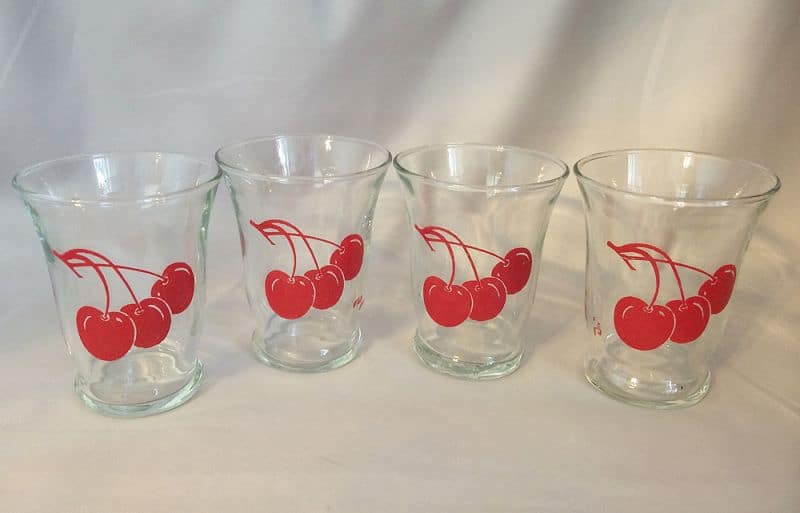
Acquiring a modern collection of Libbey Glass is not a problem. You can find it in any department store or specialized in household appliances. However, buying vintage pieces that are optimal for collection is very different. You will have to check third-party seller websites such as the following:
- Mercari
- Etsy
- eBay
- Invaluable
In Invaluable Store, you will get crystal or cut glass pieces with handmade patterns, like bowls, candlesticks, decanters, compotes, bottles, and more.
Conclusion
If you are starting your adventure as a collector, starting with Vintage Libbey Glass is not a bad idea, especially since you will not have to spend your entire pocket on them. However, to get the most out of each transaction, you should learn as much as possible about different collections.
Of course, you don’t have to be a collector to love Libbey Glasses, because the beauty of these products can brighten up the decoration of any kitchen or dining room.
